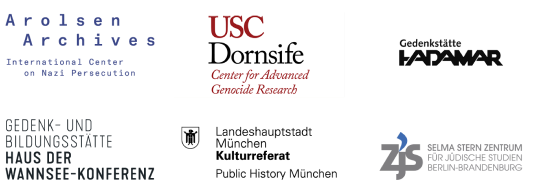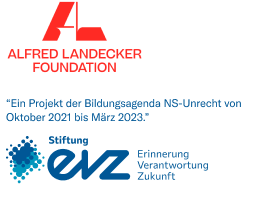Annotations
Bingen
03/20/1942
A row of trucks is waiting on the banks of the Rhine in Bingen. They served to deport 76 Jewish Bingen citizens along with their luggage.
Image: K. Kühn
Annotations
Keywords
4
Historical context
Deportation von Bingen nach Piaski am 20.03.1942
On March 20, 1942, the first deportation of Bingen Jews to occupied Eastern Europe took place. The Gestapo offices in Mainz and Darmstadt had the lead role in planning the deportation. Seventy-six people were taken to the Fruchtmarkt on the banks of the Rhine. There, trucks were ready to transport the people to Mainz where they had to board trains bound for Darmstadt. Until the actual deportation train "Da 14" left Darmstadt for occupied Poland on March 24, 1942, the persons to be deported had been kept under guard in an assembly camp at Liebig School for several days. The train took about two days for the journey from Darmstadt to Trawniki in the Lublin district. Two wagons full of sewing machines were added to the train. This seemed to point to a forced labor assignment, but was in fact used to disguise the true purpose of the deportation. From Trawniki, the deportees had to walk the remaining twelve kilometers to the Piaski ghetto, where they moved into the houses of Jews who had been murdered in the Bełżec extermination camp shortly before. As no deportees from this train survived, it can be presumed that the Bingen Jews were also murdered there.
About the image series
The photo series consists of three pictures and their backs in the format 7 x 10 cm. The photos have been preserved as original prints by the photographer’s son, Günther Kühn. Currently they are kept in a private album of the Kühn family, which contains the photo-documentary works of Karl Kühn, the photographer. The labeling of the backs of the photos and the album pages was done retrospectively by Günther Kühn. The three Bingen pictures show a short scene in the deportation process. You can see the people to be deported arriving at Bingen Fruchtmarkt on the banks of the Rhine and the trucks lined up there in a long row, complete with guards. The order of the photos implies that the photographer moved along with the people to be deported. None of the persons on the photos have yet been identified by name.
Photographer
Karl Kühn, chemist
Karl Kühn was born in Lübeck in 1887. After a trip to the Rhine in 1904, he decided to move to Bingen on the Rhine to open a drugstore and start a family there with his wife Helene who came from Salzwedel. Together, they moved the store to several different locations within Bingen before establishing the Kühn drug and photo store at Salzstraße 20. The family had six children. The 1st World War saw Karl serve in the army together with two of his sons, who both fell in action. Karl Kühn liked to take pictures and owned several cameras. He used his pictures to document events in the town, mostly not intending to publish them. He was a member of the NSDAP. During the Second World War he went on with his business. He documented war damage in Bingen, although this was prohibited. Karl Kühn died in 1963.
Provenance
The photographer who took the pictures in the photo series from Bingen was the chemist and photo shop owner Karl Kühn. He had his store not far from Fruchtmarkt, which served as an assembly point for the Jews who were to be deported. It is very probable that he learned of the event by chance and set off with his little son to take some pictures. Assuming that his camera might be confiscated or destroyed, he used one of his less expensive camera models. Kühn made the prints of the pictures himself and kept them in the attic of his house. They were only found there after Karl Kühn's son Günther Kühn had closed down the business and given up the family home. Günter Kühn digitized them and made them available to the Verein für jüdisches Bingen e.V. Today, digital copies of the pictures are held by the Osthofen Concentration Camp Memorial, the Jewish Museum Berlin, and the Museum for Jewish Heritage in New York.
Call number at source archive
ohne Signatur
Title at source archive
ohne Titel
Acknowledgements
Our heartfelt thanks are due to the family of Karl Kühn, the photographer – Günther and Ingeborg Kühn, who provided #LastSeen with the photos and with detailed information about the photographer and the context in which he took the pictures. We would also like to thank the Arbeitskreis Jüdisches Bingen for using his contacts to help us and especially Mr. Hans-Josef von Eyß for sharing the results of his research.
Text and research by Lisa Paduch.
Kooperationsverbund #LastSeen. Bilder der NS-Deportationen Dr. Alina Bothe Projektleiterin
c/o Selma Stern Zentrum für Jüdische Studien Berlin-Brandenburg
Freie Universität Berlin
Habelschwerdter Allee 34A
14195 Berlin
lastseen@zedat.fu-berlin.de
Ein Kooperationsprojekt von

Gefördert durch

Datenschutz | Impressum